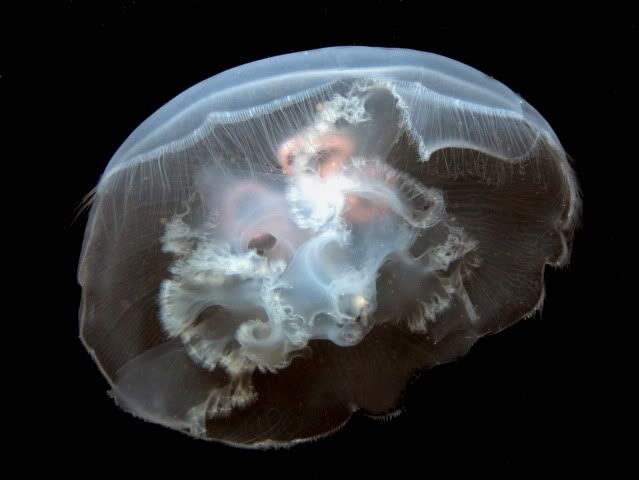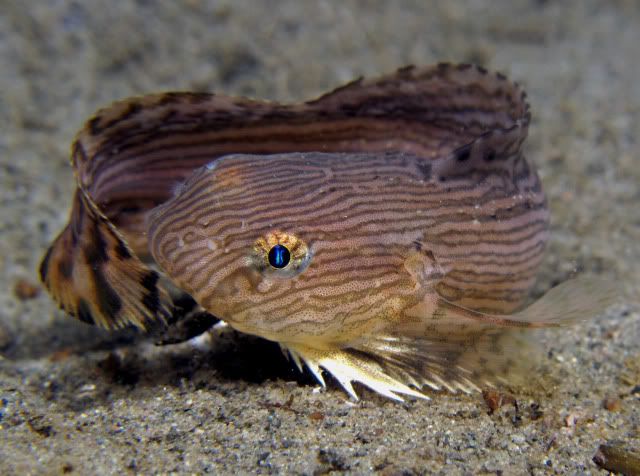Last winter, I did several dives with NW Grateful Diver, where we went hunting lumpsuckers. These are charming little fish that look like miniature helicopters, and they're found in 10 feet or so of water. We spent over an hour in the shallow eelgrass, watching them and also finding stubby squid, market squid, pipefish and other interesting eelgrass denizens.
In December I did about 20 dives there with various people. Never got below 20 feet, and most of the dives were in 10-15 feet of water. I wrote an article for our dive club newsletter. Not sure if I ever posted it on ScubaBoard ... so I will now ...
Night Moves - the Delights of "The 'Dond"
Night has always been my favorite time to dive. That’s when a lot of Puget Sound’s underwater natives come out to feed and breed. Dive sites suddenly fill up with all sorts of interesting creatures that you just don’t see during the day. And sometimes a part of a dive site that you usually avoid because it seems boring or lacking in life can suddenly take on a whole new level of excitement. Such was the case recently at one of my favorite dive sites in the south Sound – Redondo.
I arrived on a cold, mid-December evening about a half-hour before sunset. My dive buddy Casey and I had heard rumors of Pacific Spiny Lumpsuckers in an eelgrass bed on the north side of the beach, and we were intent on finding out if these elusive little fish were really there. We put our gear together as the sun set behind the crest of the Olympic Mountains, and as darkness settled in we entered at the beach north of Salty’s Restaurant. Dropping down without a surface swim we made our way down to a depth of about 10 feet and turned north, toward the eelgrass beds. This would be a very shallow dive, and one we hoped would turn up one of the Puget Sound’s most elusive and sought-after little fish. As it turned out, we found much more than we hoped for.
The ebbing tide created a mild current pushing us in the direction we wanted to go. Before long we found the eelgrass beds and slowly swam along the downslope edge looking to see what we could find. I’d been to these beds in daylight, and considered them rather boring. With darkness, however, came a whole different perspective. The eelgrass was just teeming with life. Schools of tubesnouts were swimming around, their prominent pectoral fins moving them gracefully as they fed on the tiny creatures living in this botanical nursery. A larger green shape turned out to be a penpoint gunnel, lying in wait for an unwary tubesnout to swim by.
Hooded nudibranchs, gracefully undulating as they encapsulated bits of floating plankton, provided a nice photo opportunity.
And then, perched on a blade of grass like a tiny golden jewel, we found the object of our quest - a lumpsucker, barely an inch long. As I angled in for a picture, our lights startled him off his perch and he started swimming around like a golden bumblebee, weaving between blades of grass and making it a challenge to get a picture. He was such an odd-looking little creature I was torn between the attempt at a picture and just sitting back chuckling at his funny behavior. But at last I got the shot I wanted and it was time to move on.
We found several more lumpsuckers that evening, but there was so much more to see. At one point I found myself looking at a piece of eelgrass that seemed to be looking back at me. And I realized it wasn’t eelgrass at all, but a green bay pipefish, aligned perfectly to blend in with surroundings. I snapped another picture and moved on.
A tiny red octopus – smaller than the tip of my thumb – moved along the bottom, seeking to make a meal out of one of the hundreds of miniature crabs that lived here.
Tiny comb jellies, catching the reflection of our lights, cast shimmering waves of color as they drifted along. Overhead a moon jelly moved gently by with the current.
The eelgrass beds had transformed into a miniature forest with multitudes of diverse life forms interacting with each other in a kind of enchanted dance that we – the uninvited guests – were privileged to see.
And suddenly, out of the darkness – flying at us like little jets – came a school of opalescent squid. Apparently they were attracted to our lights. But as quickly as they appeared, they decided we weren’t food, inked, and disappeared – leaving us with a “what the heck just happened” moment. That was exciting.
But now we were 40 minutes into our dive and it was time to turn and head back toward the beach.
We found even more lumpsuckers on the way back. One even tried swimming into my camera lens as I was taking its picture. It reminded me of a tiny orange helicopter with its landing gear down.
As we left the eelgrass beds behind we found yet another treasure of the night – a marbled snailfish. I hadn’t seen one of these fish in a long time, and was quite thrilled to see it here. In its classic pose it looks so much like a three-inch long puppy begging for attention.
Finally it was time to turn upslope toward the beach. But one last thrill remained. In about 4 feet of water, just as we were preparing to end the dive and stand up, Casey spotted an opalescent squid hovering just above the rocks. What a way to end the dive! We stopped for just a couple of minutes to take some pictures and watch it bobbing and weaving back and forth, trying to decide if our lights represented friend, foe, or food.
Altogether it was an 80-minute dive of virtually non-stop activity! Rarely have I seen so many delightful creatures on a single dive. But this is what night diving in Puget Sound is all about.
Redondo has long been one of my favorite Puget Sound dive sites. And although it is a wonderful place to dive during the daylight hours, at night it can provide some of the very best diving that Puget Sound has to offer ... and on this night, it was all at less than 20 feet ...
... Bob (Grateful Diver)






















